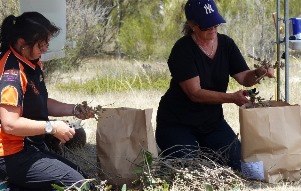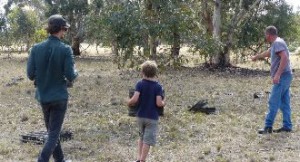Bangham campout, success for seeds!
January 15-17th, 2015
A party of nine made the trek to Eaglehawk Waterhole for a two night working bee campout.
On the first night while the weather was calm the crew went out spotlighting for rabbits (out on the sandy hills) throughout the property. Over 25 were seen out the eastern end, so some follow up is required to reduce numbers before revegetation activities commence mid-year. After returning to camp, tucking ourselves away in our sleeping bags, the nocturnal animals emerged and began their normal evening activities like calling, calling, gliding or flying from tree to tree, calling, feeding etc.
A pair of Sugar gliders (Petaurus breviceps) were seen and heard around the camp in the Stringybark and Blue Gums. Have a listen to the recording:
Click here for a sound file of a Sugar Glider call
A Tawny Frogmouth (Podargus strigoides) also joined in on the chorus.
Friday morning the crew were woken by a variety of bush-birds calling and waking us all to come out for ‘bacon and eggs’ on the BBQ. It was a welcome good night sleep, as a big day was ahead of us.
The plans for the day were announced after breakfast, so all supplies were quickly gathered. The first task for the day was to begin collecting seed while driving to look for rabbit warrens and using GPS devices to map sites for future follow up. Only a few warrens were found but plenty of seed of a variety of native plants were collected and then sorted into bags. Species like Desert Banksia (Banksia ornata), Desert Stringybark (Eucalyptus arenacea), Rough-barked Manna-gum (E. viminalis) SA Blue Gum (E. leucoxylon), Beaked Hakea (Hakea rostrata), Wallaby Grass (Austrodanthonia sp), and Swamp Sheoak (Allocasuarina paludosa) were all harvested by hand with the aim to use for future revegetation effort at the site. Once back at camp, we sorted the seed into their own bags over lunch, in readiness for drying in the sunshine.
Nature Glenelg Trust was recently awarded a grant through the 20 Million Trees program to undertake 70 ha of revegetation of trees and understorey to create a corridor between the central part of Eaglehawk Waterhole and the neighbour to the east. The Restoring Under-represented Ecological Community project will also be adding value to this revegetation project area expanding it out to cover a larger area during this time.
In the late afternoon the batch of 100 roofing tiles generously donated by Peter Guerin (Builder) from Mt Gambier, were laid out in two 50 tile grids. These grids are to help us monitor fauna presence and recovery during the long term restoration effort on Eaglehawk Waterhole. Locations where tiles were placed included an open area with Manna-gum and SA Blue gum in the middle of the revegetation area, then another site down the southern end where the Buloke grassy woodland occurs.
Ants were surveyed again in one location in response to an earlier request by the SA Museum to collect more specimens of one species they thought was new to the State. Unfortunately, their identification was not of a new species, however that will not deter us – we shall keep on trying to document the variety we have as restoration continues!
We thank the Commonwealth Government and Natural Resources SE for the funding support for our projects in the Bangham area.
A special thanks to Ben Kester for being a ‘life saver’ in our moment of need for our lone sheep.
By Bryan Haywood



